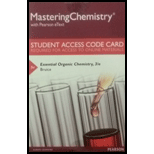
Concept explainers
- a. How many hydrogens does an
alkane with 17 carbons have? - b. How many carbons does an alkane with 74 hydrogens have?
(a)
Interpretation:
The number of hydrogen atoms should be identified in the alkanes with 17 carbons.
Concept introduction:
Any organic molecule can be named by using certain rules given by IUPAC (International Union for Pure and applied chemistry). IUPAC name consists of three parts in major namely prefix suffix and root word.
Prefix represents the substituent present in the molecule and its position in the root name.
Suffix denotes the presence of functional group if any in the molecule. It can be an alkene, alkyne, alcohol, carboxylic acid, alcohol etc.
Root word represents the longest continuous carbon skeleton of the organic molecule.
Answer to Problem 1P
The number of hydrogens atoms in alkanes with 17 carbons are
Explanation of Solution
Analyzing for the statement (a):
Let us consider the following general molecular formula
There is 17 carbon atoms in an alkane
The numbers of hydrogen atoms are in (36)
(b)
Interpretation:
The number of carbon atoms should be identified in the alkanes with 74 hydrogens.
Concept introduction:
Any organic molecule can be named by using certain rules given by IUPAC (International Union for Pure and applied chemistry). IUPAC name consists of three parts in major namely prefix suffix and root word.
Prefix represents the substituent present in the molecule and its position in the root name.
Suffix denotes the presence of functional group if any in the molecule. It can be an alkene, alkyne, alcohol, carboxylic acid, alcohol etc.
Root word represents the longest continuous carbon skeleton of the organic molecule.
Answer to Problem 1P
The number of carbon atoms in alkane with 74 hydrogens in
Explanation of Solution
Analyzing for the statement (a):
Let us consider the following general molecular formula
The numbers of hydrogen atoms are in (36)
Therefore, the number of carbon atom in this compound is
Want to see more full solutions like this?
Chapter 3 Solutions
Mastering Chemistry With Pearson Etext -- Standalone Access Card -- For Essential Organic Chemistry (3rd Edition)
- In the next chapter we'll look at cycloalkanes—saturated cyclic hydrocarbons—and we’ll see that the molecules generally adopt puckered, nonplanar conformations. Cyclohexane, for instance, has a puckered shape like a lounge chair rather than a flat shape. Why?arrow_forwardFour haloalkanes have approximate boiling points of 50°C, 70°C, 90°C and 102°C. Which compound in Figure 4 has an approximate boiling point of 90°C? * A B C Darrow_forwardWhich list of hydrocarbons is in the correct order from the least number of carbons to the most? a. methane, ethane, propane, butane, pentane b. pentane, sextane, septane, octane, nonane c. butane, decane, octane, nonane, methane d. methane, ethane, pentane, butane, propane e. ethane, methane, propane, decane, octanearrow_forward
- By adding tetraethyl lead to iso-octane: A. Exhaust smoke can be reduced B. Knocking can be completely suppressed C. Octane number above 100 can be obtained D. Specific fuel consumption can be reducedarrow_forwardDraw an alkane that has only tertiary hydrogens.arrow_forwardHow many different alkenes can be formed from the haloalkane in Figure 20? Take stereoisomerism into account.arrow_forward
- 4-ethyl-5,5-dimethyl-3-isopropyloctane whay does this structure look like with all the C's and H's?arrow_forwardDraw the following compounds: a) 2-Bromobicyclo[3.3.1]nonane b) 2-Methylbicyclo[2.2.2]octane c) 1,2-Dichlorocyclohexene d) 4,5-Dibromo-1-pentenearrow_forwardComplete them draw structure of themarrow_forward

 Chemistry by OpenStax (2015-05-04)ChemistryISBN:9781938168390Author:Klaus Theopold, Richard H Langley, Paul Flowers, William R. Robinson, Mark BlaserPublisher:OpenStax
Chemistry by OpenStax (2015-05-04)ChemistryISBN:9781938168390Author:Klaus Theopold, Richard H Langley, Paul Flowers, William R. Robinson, Mark BlaserPublisher:OpenStax
 Chemistry: An Atoms First ApproachChemistryISBN:9781305079243Author:Steven S. Zumdahl, Susan A. ZumdahlPublisher:Cengage Learning
Chemistry: An Atoms First ApproachChemistryISBN:9781305079243Author:Steven S. Zumdahl, Susan A. ZumdahlPublisher:Cengage Learning
 ChemistryChemistryISBN:9781305957404Author:Steven S. Zumdahl, Susan A. Zumdahl, Donald J. DeCostePublisher:Cengage Learning
ChemistryChemistryISBN:9781305957404Author:Steven S. Zumdahl, Susan A. Zumdahl, Donald J. DeCostePublisher:Cengage Learning





